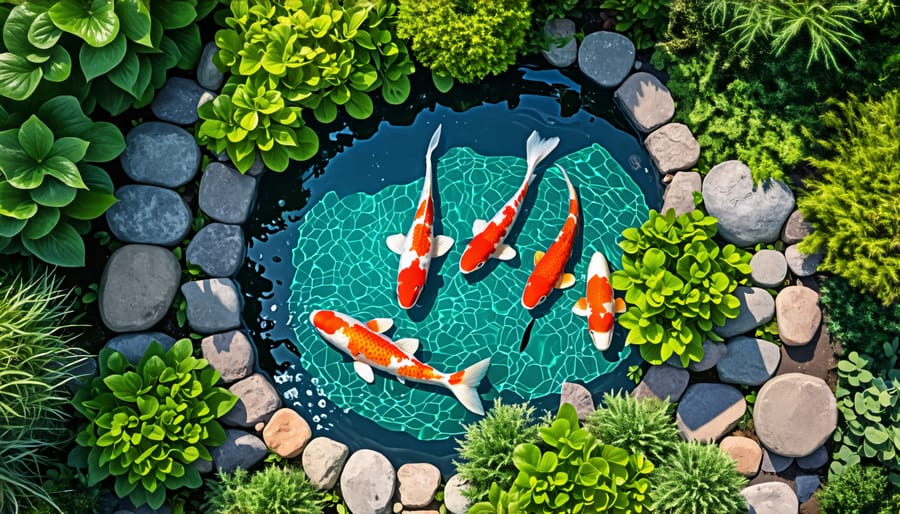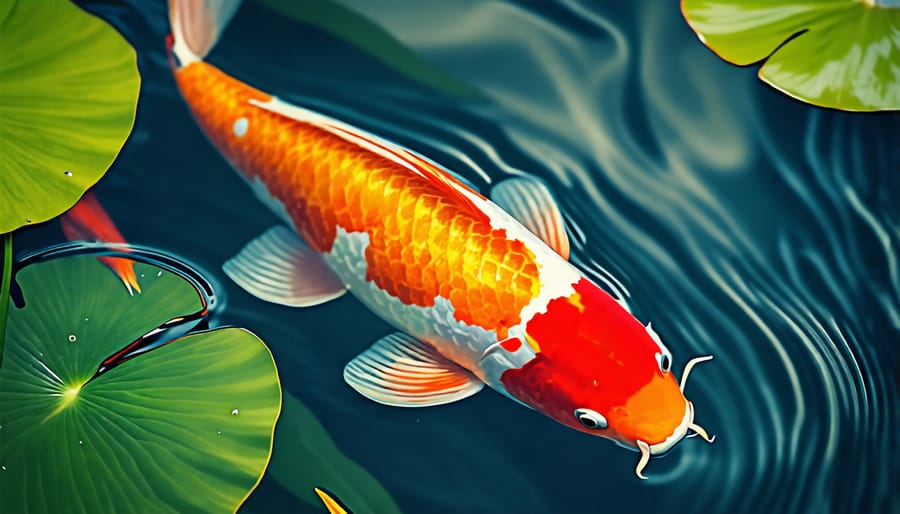
Cultivate a Thriving Koi Pond Ecosystem in Your Backyard
Create a thriving koi pond ecosystem by choosing the right location with ample sunlight and natural wind protection. Install a high-quality filtration system to maintain clean, healthy water. Regularly test water parameters like pH, ammonia, and nitrates to ensure optimal conditions. Introduce aquatic plants that oxygenate the water, provide shade, and enhance your backyard’s visual appeal. Integrating various plant species not only supports biodiversity but also establishes a natural balance. Lastly, monitor koi feeding habits to prevent overfeeding, which can lead to water quality deterioration. These steps will transform your backyard into a wildlife wonderland and guarantee a harmonious pond environment. For further tips on creating a vibrant outdoor space, explore how to enhance your backyard.
Designing Your Koi Pond

Choosing the Right Location
When setting up a koi pond, selecting the right location is crucial for creating a thriving ecosystem. Start by considering sunlight. Koi ponds need a balance of sun and shade. Aim for 4-6 hours of sunlight a day to encourage healthy plant growth while preventing the water from overheating. Too much sun can increase algae growth, while too much shade can stifle your plants.
Next, think about accessibility. You’ll want a place that’s easy to reach for maintenance and feeding but also visible enough to enjoy the beauty of your fish and plants. Avoid areas near heavy leaf fall, which could clog your pond’s filtration system.
Also, check for level ground. A slope can disrupt the water balance and make installation tricky. If drainage is a concern, make sure excess water has a path away from the pond. By considering these factors, you’ll set the stage for a beautiful and sustainable koi pond environment.
Determining the Proper Size and Shape
Choosing the right size and shape for your koi pond is essential for both functionality and visual appeal. When considering the size, remember that koi require ample space to thrive. A minimum depth of three feet is recommended to accommodate their growth and to prevent predators. Larger ponds are easier to maintain, as they provide a more stable environment, helping to naturally regulate temperature and water quality. For width and length, aim for at least 1,000 gallons to ensure enough room for the fish to swim and grow comfortably.
Shape is another important factor and should harmonize with your garden’s overall design. Whether you prefer the organic, flowing lines of a natural pond or the structured elegance of a geometric shape, ensure your choice enhances the landscape. Curved edges can offer a natural look and are easier to clean, while straight-edged designs might suit more formal gardens. Ultimately, your pond should reflect your personal style while creating a balanced habitat for your koi.
Essential Elements of a Koi Pond Ecosystem
Filtration Systems and Water Quality
Creating a balanced koi pond ecosystem requires maintaining pristine water quality, and a reliable filtration system is key to achieving this. For both beginners and seasoned pond enthusiasts, understanding filtration is crucial. When planning your pond, consider incorporating a DIY filtration system to effectively remove debris and harmful substances. A good filtration setup usually combines mechanical and biological components. Mechanical filters trap floating debris while biological filters use beneficial bacteria to break down waste and harmful ammonia. It’s like nature lending a helping hand to keep your koi healthy. Regular cleaning and monitoring ensure your system runs smoothly and prevents clogging. Personal experience shows that investing time in setting up a robust filtration system pays off with crystal-clear water and vibrant, happy koi. This method not only maintains water quality but also enhances the overall beauty and tranquility of your pond, making it a delightful addition to your outdoor space.


Flora: Plants that Support the Ecosystem
In creating a balanced koi pond ecosystem, choosing the right plants is crucial as they enhance water quality and establish a vibrant natural habitat for your koi. Start by introducing a mix of emergent, floating, and submerged aquatic plants. These types play different roles in maintaining clarity and balance in your pond.
Emergent plants like cattails and water iris stand tall along the pond’s edge, keeping soil and debris in check. Their roots stabilize the pond floor and help filter pollutants, creating cleaner water for your koi. Meanwhile, floating plants such as water lettuce and water hyacinth provide shade that reduces algae growth. They act as a natural blanket, protecting koi from overexposure to sunlight while keeping water temperature more stable.
Submerged plants like anacharis or hornwort work wonders as oxygenators, releasing crucial oxygen through photosynthesis. This process naturally aerates the water, benefiting the health and vitality of your koi. Additionally, both submerged and floating plants offer hiding spots and breeding grounds for koi, further mimicking a natural habitat.
By thoughtfully incorporating these plant varieties, not only will your koi thrive, but your pond will also turn into a zen-like garden retreat right in your backyard. Happy water gardening!
Introducing Koi to Your Pond
Selecting Healthy Koi
Choosing healthy koi is essential for maintaining a vibrant pond ecosystem. Start by observing their behavior; lively and curious koi indicate vigor. A robust koi will actively swim and explore its surroundings. When selecting, check for clear, bright eyes that are indicative of good health, and ensure their scales and fins are smooth and intact, without any signs of damage or discoloration. Avoid koi that show signs of lethargy or float near the surface without purpose, as these may suggest underlying health issues.
Next, consider the color and patterns of the koi. Vibrant colors signify a well-nourished fish. While the beauty of their patterns may be subjective, a consistent and vivid coloration is often a good sign of overall health. Additionally, ensure their bodies appear balanced and well-proportioned, as asymmetries might indicate genetic or health problems. Always source koi from reputable breeders or shops that maintain clean facilities, as this reflects the care and health of their fish stock. Through these careful selections, you’ll contribute greatly to the flourishing balance of your koi pond environment.
Acclimatization Process
Introducing your koi to their new pond environment requires a gentle acclimatization process to ensure they thrive without stress or health issues. Start by preparing a quarantine tank to house the koi temporarily. This step helps them adjust to the new water while allowing you to monitor their health closely. Before moving koi into the pond, float their sealed transport bag in the pond water for about 20-30 minutes. This lets the water temperature gradually equalize, reducing the risk of thermal shock.
Next, open the bag and slowly add small amounts of pond water every five minutes. This gradual mixing helps the koi acclimate to the pH and other water chemistry differences. After an hour, gently release the koi into the pond, avoiding any netting that might stress them. Keep an eye on your koi over the next few days for any signs of discomfort like erratic swimming or gasping at the surface, which might indicate further adjustment is needed. Remember, patience is key to creating a harmonious koi pond ecosystem where your fish can flourish.
Maintaining a Balanced Ecosystem
Routine Maintenance Tasks
Maintaining a koi pond is a delightful responsibility that ensures your finned friends and aquatic plants thrive in harmony. Firstly, check the water quality weekly; use a test kit to monitor pH, ammonia, and nitrate levels, making adjustments as needed to maintain a balanced ecosystem. Regularly clean the pond by removing debris like leaves and twigs, which can disturb water clarity and quality. Encourage a healthy environment by cleaning the filter system monthly to ensure it operates at peak efficiency. It’s also crucial to inspect and maintain your pond equipment; pumps, aerators, and UV filters should be checked regularly for any wear or faults. Feeding your koi properly is another key task — provide them with high-quality food designed for koi and avoid overfeeding to prevent water pollution. Lastly, seasonally attend to plant life; trimming or relocating plants can provide the right balance of shade and nutrients. These routine tasks not only enhance the beauty of your pond but also create a stable and inviting habitat for your koi.
Troubleshooting Common Issues
Struggling with murky water or green algae in your koi pond? Start by checking your filtration system to help maintain clear water. Clean or replace filters regularly and ensure the pump is working efficiently. For algae blooms, consider adding aquatic plants like water lilies—they compete for nutrients and block sunlight, curbing algae growth. To keep your koi healthy, monitor water temperature and quality, adjusting as necessary with seasonal changes. Don’t forget to scoop out debris often. Consistency is key, so develop a maintenance routine that suits your lifestyle. Your koi will thank you!
Conclusion
Building your own koi pond is a rewarding journey filled with learning and the joy of watching your personal ecosystem thrive. Remember, the essential steps involve careful planning, thoughtful construction, and diligent maintenance. By understanding the needs of your koi and the environment they live in, you can create a beautiful and balanced aquatic habitat. Don’t be afraid to start small; every pond begins somewhere. Whether you’re a seasoned water gardener or a curious beginner, embrace the process and let your passion for ponds guide you. Dive in, and discover the tranquility and beauty a koi pond can bring to your outdoor space.
